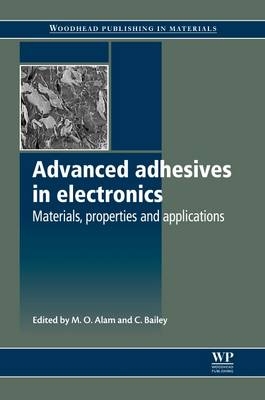
Advanced Adhesives in Electronics
Woodhead Publishing Ltd (Verlag)
978-1-84569-576-7 (ISBN)
- Titel ist leider vergriffen;
keine Neuauflage - Artikel merken
Adhesives for electronic applications serve important functional and structural purposes in electronic components and packaging, and have developed significantly over the last few decades. Advanced adhesives in electronics reviews recent developments in adhesive joining technology, processing and properties.The book opens with an introduction to adhesive joining technology for electronics. Part one goes on to cover different types of adhesive used in electronic systems, including thermally conductive adhesives, isotropic and anisotropic conductive adhesives and underfill adhesives for flip-chip applications. Part two focuses on the properties and processing of electronic adhesives, with chapters covering the structural integrity of metal-polymer adhesive interfaces, modelling techniques used to assess adhesive properties and adhesive technology for photonics.With its distinguished editors and international team of contributors, Advanced adhesives in electronics is a standard reference for materials scientists, engineers and chemists using adhesives in electronics, as well as those with an academic research interest in the field.
M. O. Alam is a Researcher in the School of Computing and Mathematical Sciences at the University of Greenwich, UK. Christopher Bailey is a Professor in the School of Computing and Mathematical Sciences at the University of Greenwich, UK.
Contributor contact details
Chapter 1: Introduction to adhesives joining technology for electronics
Abstract:
1.1 Introduction
1.2 Classification of adhesives used in electronic packaging
1.3 A brief overview of electronic assemblies
1.4 Typical uses of advanced adhesives in electronics
Chapter 2: Thermally conductive adhesives in electronics
Abstract:
2.1 Introduction
2.2 Model of heat conductance
2.3 Heat transport in thermally conductive adhesives
2.4 Thermally conductive fillers
2.5 Role of polymer base materials
2.6 Thermal conductivity of adhesives and methods for its measurement
2.7 Conclusions
Chapter 3: Anisotropic conductive adhesives in electronics
Abstract:
3.1 Introduction
3.2 Nature of adhesive bond
3.3 Materials and processing
3.4 Critical loading
3.5 Evaluation methods
3.6 Case studies
3.7 Conclusions
3.8 Acknowledgments
3.10 Appendix: List of abbreviations
Chapter 4: Isotropic conductive adhesives in electronics
Abstract:
4.1 Introduction
4.2 General isotropic conductive adhesive (ICA) properties
4.3 Reliability
4.4 Modeling
4.5 Nanotechnologies in isotropic conductive adhesives
4.6 Conclusions
Chapter 5: Underfill adhesive materials for flip chip applications
Abstract:
5.1 Introduction: flip chip and direct chip attachment technology
5.2 Advantages of direct chip attachment technology
5.3 Reliability challenge of flip chip technology
5.4 Advances in the flip chip underfill process and encapsulant materials
5.5 New material challenges to lead-free solder
5.6 The ′no-flow′ pre-applied underfill process
5.7 The wafer level pre-applied underfill process
5.8 The wafer level dual encapsulation process
5.9 Conclusions
Chapter 6: Structural integrity of metal–polymer adhesive interfaces in microelectronics
Abstract:
6.1 Introduction
6.2 Theoretical considerations of work of fracture and bonding strength of adhesive joints
6.3 Chemical and physical intermolecular interactions at interfaces
6.4 Other influential factors determining bond strength of real adhesive joints
6.5 Effect of environmental factors
6.6 Interconnections using electrically conductive adhesives
6.7 Conclusions
Chapter 7: Modelling techniques used to assess conductive adhesive properties
Abstract:
7.1 Introduction
7.2 Numerical modelling technologies
7.3 Modelling applied to packaging processes
7.4 Modelling the thermal, electrical and mechanical performance of adhesives
7.5 Future trends
7.6 Conclusions
Chapter 8: Adhesive technology for photonics
Abstract:
8.1 Introduction
8.2 The major characteristics of adhesives for photonic applications
8.3 Types of adhesive used in photonics
8.4 Major applications of adhesives in photonics
8.5 Adhesives for photonic packaging
8.6 Adhesives used in photonic devices
8.7 Typical challenges for reliable fabrication of photonic devices
8.8 Conclusions
Index
| Reihe/Serie | Woodhead Publishing Series in Electronic and Optical Materials |
|---|---|
| Verlagsort | Cambridge |
| Sprache | englisch |
| Maße | 156 x 234 mm |
| Gewicht | 570 g |
| Themenwelt | Technik ► Elektrotechnik / Energietechnik |
| ISBN-10 | 1-84569-576-3 / 1845695763 |
| ISBN-13 | 978-1-84569-576-7 / 9781845695767 |
| Zustand | Neuware |
| Haben Sie eine Frage zum Produkt? |
aus dem Bereich


